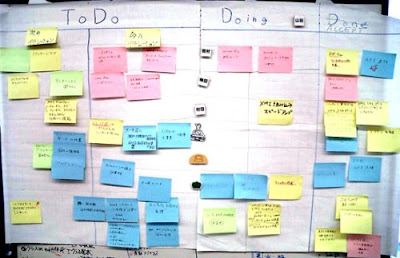Kanban Applied to Software Development: From Agile to Lean
 Most of my experience of agile software development has been with Scrum, and some aspects of eXtreme Programming (XP). However, for quite a while now, I've been reading quite a bit about Lean software development, and Kanban.
Most of my experience of agile software development has been with Scrum, and some aspects of eXtreme Programming (XP). However, for quite a while now, I've been reading quite a bit about Lean software development, and Kanban.For those that don't really know much about Kanban, I found the following article on InfoQ quite an interesting insight:
http://www.infoq.com/articles/hiranabe-lean-agile-kanban
I haven't made the jump and tried Lean with any of my teams yet. To be honest, I've had such great success with Scrum, across so many teams now, it's almost a case of "if it's not broken, don't try to fix it".
Having said that, I do see that the overhead of Sprint planning in Scrum is often quite onerous. Although I really value the predictability teams can achieve by estimating in points and tracking Velocity and Burndown. I've seen this help so many teams to deliver on their commitments, meeting expectations and building strong business relationships as a result.
But I can't help being slightly fascinated by the idea of cycle time in Lean software development. This is the idea that a team's cycle time represents the average number of cards - or User Stories - a team can deliver in a fixed period of time (iteration). To work best, user stories would ideally be broken down until they are all a similar size. Although not necessarily, as what's important with cycle time is the average number of user stories that can be delivered in a Sprint. When you think about it statistically, the concept is actually very similar to Velocity.
What if a team could achieve the same level of reliability and predictability, without the need for any detailed estimating and planning? There would certainly be an increase in the team's productivity, due to the time saved on Sprint Planning.
My sense is that doing Lean - and using cycle time to predict when things can be delivered - may well be appropriate for business as usual. Ongoing development is, by nature, more routine. And therefore the team is more likely to get into a more predictable rhythm. But for bigger projects, where costs need to be estimated in order to secure funding, and the project team is not yet established, I'm not sure if cycle time would be predictable enough?
Kelly.
P.S. Click one of the icons below to join the growing community of people keeping up with this blog by RSS or by email...
























19 May 2009 09:14
Thank you for your posting.
21 May 2009 00:46
I agree with you on this Kelly. Using cycle time may work with sustaining engineering or when you are churning out very similar products on a regular basis.
Perhaps there is an opportunity for a hybrid approach, where you use cycle time but then flag specific user stories and/or tasks that are out of the norm....and do planning poker or something on just those tasks. In some environments you may get the benefit of less planning on 80% of the work, AND the benefit of accurate estimates on the really new work.
Josh Nankivel
pmStudent.com
27 July 2009 15:08
Hi Kelly,
I think some clarification is needed on cycle time. It is not exactly how you define it: " a team's cycle time represents the average number of cards - or User Stories - a team can deliver in a fixed period of time (iteration)." This definition is actually for through-put - which essentially is what Velocity measures.
In lean, there are no iterations - by definition it is not iterative. Cycle time is then how long it takes for a 'unit' to get through the system/process. So for a lean team, if takes 2 days to complete a story point, the cycle-time is 2 days. One can still extrapolate that a story twice as big will take 4 days etc.
Giora